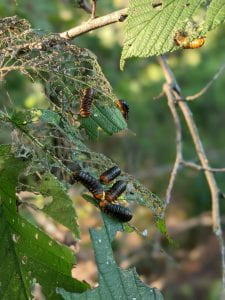Published in The Journal on August 1, 2022
The latest social media sensation of Noble County is a black bear that has been frequently seen in Belle Valley. Since male black bear home ranges can span 100 miles and this bear is not the only bear that has paid us a visit recently, it is important for all local citizens to become bear aware. A black bear could very well visit your yard, garden, corn field, or trash bin too. If you were to encounter a bear in a residential area, would you know what to do? I hope you will after reading this week’s article.
According to Ohio Division of Wildlife Officer- Brad St. Clair, the black bear that is currently being observed in our area is most likely a young bear (around 18 months old) that has recently left the care of its mother and is exploring to develop its own home range.
Bears are typically solitary animals, although cubs will remain with their mother for slightly longer than a year. On average in our region black bears weigh around 200 pounds, but if well fed, males could exceed 600 pounds. A typical black bear will be 3 feet at shoulder height while on all four paws. A healthy bear has a life expectancy of 25 years. At this time, bears are regarded as endangered in Ohio. It is likely that the bears we see in Noble County have traveled in from Pennsylvania or West Virginia.
Black bears are intelligent and curious animals. They can be active at any time of day but are most active at dawn and dusk. Because bears are omnivorous creatures, they will readily go through garbage bins, gardens, orchards, corn fields, birdfeeders, and beehives in search of tasty treats. They can be destructive in their searches and will often revisits sites where they were previously successful getting a meal.
To prevent a bear from treating your property like a buffet, clean up any human, pet, or wildlife food residue that is outside and store food waste in an indoor location until trash day. This includes cleaning outdoor cooking equipment like grills and smokers after use. Gardens, orchards, and beehives can be protected with electric fence if needed to keep bears (and neighbors) away.
The idea of having an encounter with a bear anywhere can be frightening. But bears, like many other animals, do not seek out confrontation with humans. Interactions between bears and people are typically accidental and rarely lead to aggressive responses, unless a human or pet is behaving in a threatening manner toward the bear or a bear’s cubs. Bears will avoid pets that are leashed or caged but won’t hesitate to defend themselves against an aggressive pet that invades their space. If bears are known to be in the area, do not allow pets to roam without set boundaries.
If you see a bear from inside a vehicle or building, stay inside and leave the bear alone until it chooses to leave. If you encounter a bear in-person, NEVER turn your back to the bear or run away. Make your body look as big as possible, make noise, and keep your distance. Calmy back away from the bear while facing it until you reach a safe location or the bear leaves.
As mentioned previously, bears are curious and may try to figure out what you are. Behavior cues like standing upright to look at you or moving closer to see or smell are not aggressive movements. If the bear moves toward you, continue to face the bear, wave your arms wildly, shout, and swing an object like a stick or bag between you and the bear. These actions should scare the bear into retreating from the location.
Having bears in the area is a sign of a healthy and thriving woodland ecosystem. But having bears near residences requires intelligence on our part to reduce the attractiveness of our home spaces to bears. The best way to deter bears from visiting too close is to remove or protect potential food sources on the property.
If you have concerns regarding black bear biology or nuisance bears, consult the resources readily available from the Ohio Department of Wildlife (ohiodnr.gov) or the Pennsylvania Game Commission (pgc.pa.gov). To help the Ohio Department of Natural Resources track wildlife activity, you can report wildlife sightings of all kinds anytime online at: https://apps.ohiodnr.gov/wildlife/speciessighting/.
Share this information about being bear aware with your family, friends, and neighbors to help reduce the likelihood of conflict between black bears and people in our community.
 If you are viewing this page, we likely met at an Extension event in the Noble County area, a statewide event like Farm Science Review, or perhaps a National Conference. Thank you for visiting this website to learn more about what Noble ANR is about! Please scroll down to browse a variety of articles that pertain to Noble County’s Agriculture and Natural Resource interests. Feel free to contact me for more information by leaving a comment, emailing gelley.2@osu.edu, or calling the Noble County OSU Extension Office at 740-305-3173.
If you are viewing this page, we likely met at an Extension event in the Noble County area, a statewide event like Farm Science Review, or perhaps a National Conference. Thank you for visiting this website to learn more about what Noble ANR is about! Please scroll down to browse a variety of articles that pertain to Noble County’s Agriculture and Natural Resource interests. Feel free to contact me for more information by leaving a comment, emailing gelley.2@osu.edu, or calling the Noble County OSU Extension Office at 740-305-3173.





